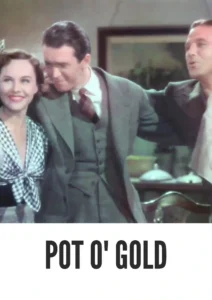Contact: [email protected]
Video Sources 0 Views
- Pot o' Gold


Synopsis
Table of Contents
ToggleReview: Pot o’ Gold (1941) – A Heartfelt Musical Comedy Gem

Introduction
Pot o’ Gold, released in 1941, is a delightful musical comedy directed by George Marshall. Filled with toe-tapping tunes, charming performances, and heartwarming moments, this classic film continues to enchant audiences with its timeless appeal and infectious spirit. In this review, we’ll explore the whimsical world of Pot o’ Gold and its enduring legacy in the realm of musical cinema.
Check The Full Colorized Movies List
Check Our Colorized Movies Trailer Channel
Understanding Pot o’ Gold (1941): Director, Cast, and Genre
Directed by George Marshall, Pot o’ Gold features an ensemble cast led by James Stewart and Paulette Goddard. The film belongs to the musical comedy genre, known for its catchy songs, colorful characters, and feel-good vibes.
Exploring the World of Pot o’ Gold (1941): Plot and Characters
Pot o’ Gold tells the story of Jimmy Haskell, a down-on-his-luck musician who stumbles upon a talented band led by Molly McCorkle. As Jimmy becomes entangled in the band’s misadventures and romantic entanglements, he discovers the true power of music to bring people together and uplift spirits.
The Art of Film Colorization
While Pot o’ Gold was originally filmed in black and white, its early colorized version adds a new layer of vibrancy to its musical numbers and whimsical set pieces. The colorization process enhances the film’s visual appeal and captures the joyous energy of its musical performances with dazzling clarity.
Early Colored Films: A Brief History
The history of early colored films is marked by innovation and experimentation as filmmakers sought to enhance the visual appeal of their movies. From hand-tinted frames to pioneering technicolor processes, the evolution of colorization techniques transformed the cinematic landscape, offering audiences a new way to experience the magic of musical cinema.
Pot o’ Gold (1941) and Its Early Colored Version
The decision to release Pot o’ Gold in a colorized format was made with the intention of immersing audiences in the colorful world of its musical numbers and whimsical set pieces. While some purists may prefer the original black and white version, the early colorized edition of Pot o’ Gold adds a new layer of vibrancy to its visual storytelling and captures the joyous energy of its musical performances with dazzling clarity.
The Debate Over Film Colorization
The debate over film colorization continues to divide audiences and industry professionals alike. While some argue that colorization breathes new life into classic films and makes them more accessible to modern audiences, others maintain that it compromises the artistic integrity of the original work. As technology advances and filmmaking techniques evolve, the debate over colorization remains a topic of ongoing discussion within the film community.
Examining Pot o’ Gold (1941) as an Early Colored Film
Viewing Pot o’ Gold in its early colorized iteration offers audiences a fresh perspective on its whimsical world and infectious musical numbers. The colorization process enhances the film’s visual appeal and captures the joyous energy of its musical performances with dazzling clarity. As viewers are swept away by the charm and charisma of Jimmy Haskell and Molly McCorkle, they are treated to a visual feast that celebrates the transformative power of music.
Influence and Legacy: Pot o’ Gold (1941)’s Impact on Cinema
Pot o’ Gold is widely regarded as a delightful musical comedy that continues to enchant audiences with its infectious spirit and timeless charm. Its memorable songs, colorful characters, and heartwarming story have left an indelible mark on the world of musical cinema, inspiring countless filmmakers and entertainers to create their own musical masterpieces.
Director’s Cinematic Legacy: Beyond Pot o’ Gold (1941)
George Marshall’s directorial legacy extends far beyond Pot o’ Gold, encompassing a diverse body of work that includes acclaimed films such as Destry Rides Again and How the West Was Won. As one of the most versatile filmmakers of his generation, Marshall was known for his ability to craft entertaining and heartfelt stories that resonated with audiences of all ages. Pot o’ Gold stands as a testament to his talent and creativity, solidifying his reputation as one of the great directors of classic Hollywood cinema.
Themes Explored in Pot o’ Gold (1941)
At its core, Pot o’ Gold explores themes of friendship, perseverance, and the transformative power of music. Through its whimsical characters and infectious musical numbers, the film celebrates the joy of following one’s dreams and finding happiness in unexpected places.
Reception and Controversy Surrounding Pot o’ Gold (1941)
Upon its release, Pot o’ Gold received widespread critical acclaim for its infectious spirit, memorable songs, and charming performances. While the decision to release the film in a colorized format sparked debate among purists, its enduring popularity has cemented its status as a beloved classic of the musical comedy genre.
Where to Watch Pot o’ Gold (1941) Online
For those eager to experience Pot o’ Gold for themselves, the film is readily available on popular streaming platforms such as Amazon Prime Video, Google Play Movies, and iTunes. Whether viewed in its original black and white format or its early colorized iteration, Pot o’ Gold offers a cinematic experience that is both whimsical and visually stunning.
FAQs About Pot o’ Gold (1941)
1. Is Pot o’ Gold based on a true story?
No, Pot o’ Gold is a fictional musical comedy that celebrates the joy of music and friendship through the whimsical adventures of its characters. While the film’s storyline may draw inspiration from real-life experiences, its plot and characters are works of fiction.
2. Who starred in Pot o’ Gold?
Pot o’ Gold stars James Stewart in the role of Jimmy Haskell, a down-on-his-luck musician who discovers the transformative power of music through his friendship with Molly McCorkle, played by Paulette Goddard. The film features a talented ensemble cast, including Horace Heidt and Charles Winninger.
3. What is the central message of Pot o’ Gold?
At its core, Pot o’ Gold celebrates the joy of music and the power of friendship to overcome adversity. Through its whimsical characters and infectious musical numbers, the film reminds audiences of the importance of following one’s dreams and finding happiness in unexpected places.
4. Why was Pot o’ Gold released in a colorized format?
The decision to release Pot o’ Gold in a colorized format was made with the intention of immersing audiences in the colorful world of its musical numbers and whimsical set pieces. While some purists may prefer the original black and white version, the early colorized edition of Pot o’ Gold adds a new layer of vibrancy to its visual storytelling and captures the joyous energy of its musical performances with dazzling clarity.
5. What is the legacy of Pot o’ Gold?
Pot o’ Gold is widely regarded as a delightful musical comedy that continues to enchant audiences with its infectious spirit and timeless charm. Its memorable songs, colorful characters, and heartwarming story have left an indelible mark on the world of musical cinema, inspiring countless filmmakers and entertainers to create their own musical masterpieces.
6. Are there any sequels or remakes of Pot o’ Gold?
No, there have been no official sequels or remakes of Pot o’ Gold. However, the film’s enduring popularity has inspired countless reinterpretations and homages in various media. Nonetheless, none have captured the whimsical charm and infectious spirit of the original 1941 classic.
7. Where can I watch Pot o’ Gold online?
For those eager to experience Pot o’ Gold for themselves, the film is readily available on popular streaming platforms such as Amazon Prime Video, Google Play Movies, and iTunes. Whether viewed in its original black and white format or its early colorized iteration, Pot o’ Gold offers a cinematic experience that is both whimsical and visually stunning.
Conclusion
In conclusion, Pot o’ Gold (1941) stands as a delightful musical comedy gem that continues to enchant audiences with its infectious spirit, memorable songs, and heartwarming story. Whether viewed in its original black and white format or its early colorized iteration, George Marshall’s insightful direction and the charming performances of the cast offer a cinematic experience that is both whimsical and visually stunning. As viewers are swept away by the joyous energy of Jimmy Haskell and Molly McCorkle, they are reminded of the transformative power of music to uplift spirits and bring people together. Pot o’ Gold remains a timeless classic that continues to entertain and inspire audiences of all ages.











